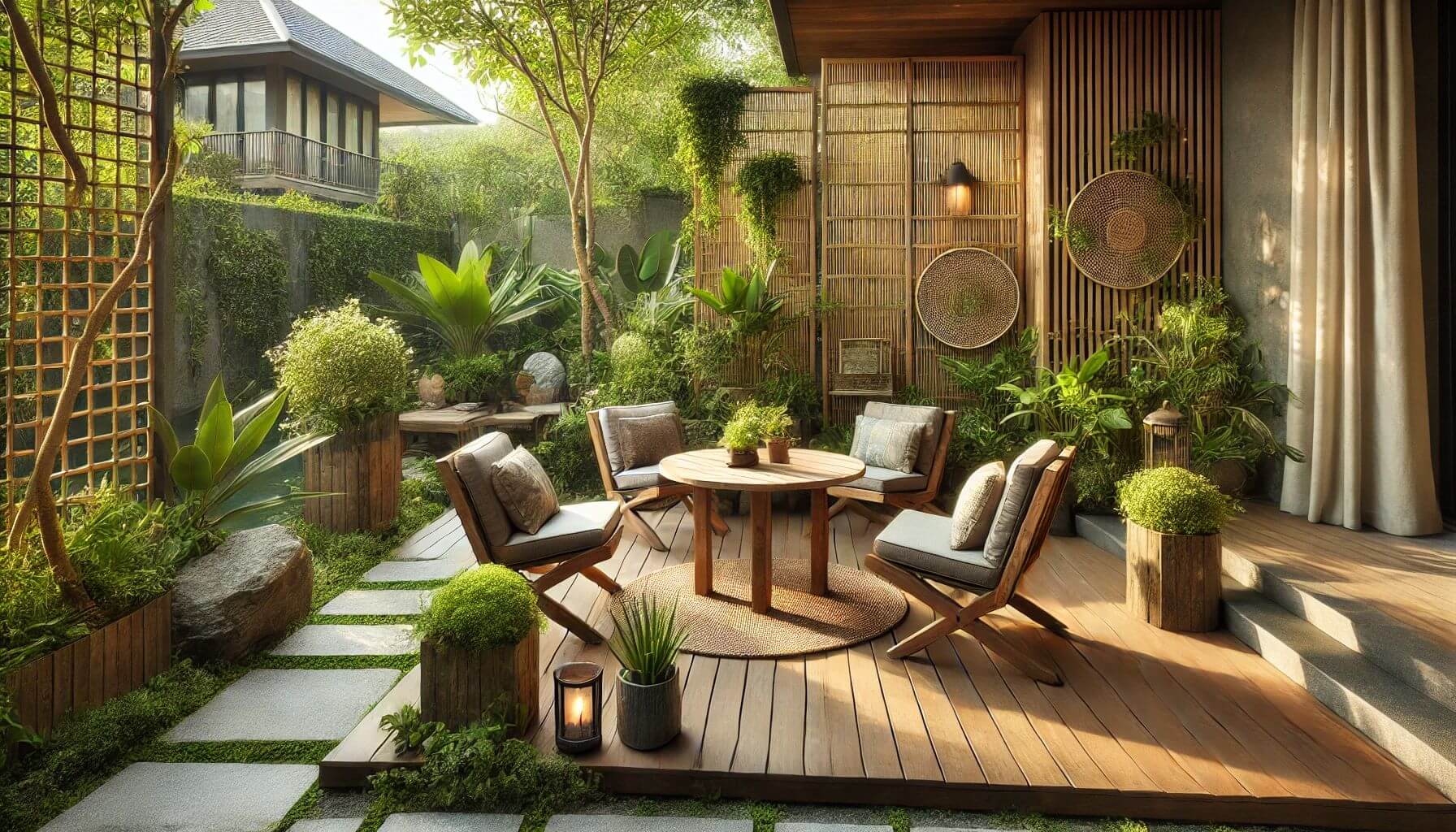
In the heart of nature-inspired design lies the concept of Earthy Elegance, a design ethos that emphasizes the beauty and tranquility of natural materials and textures in creating serene outdoor spaces. This comprehensive guide explores the essence of crafting organic patios that serve as a harmonious extension of the natural world, providing a sanctuary where one can connect with the earth’s inherent beauty.
Embracing Natural Materials
The foundation of an organic patio is the thoughtful selection of natural materials that not only blend seamlessly with the outdoor environment but also promote sustainability and eco-friendliness.
Stone: The Ultimate Earth Element
Stone, in its myriad forms, from sleek slate to rustic flagstone, offers durability and timeless beauty. Incorporating stone into patio floors, walls, or as accents, adds texture and a sense of grounding to outdoor spaces.
Wood: Warmth and Versatility
Wood brings warmth and organic beauty to patios, with options ranging from cedar and teak to reclaimed wood. Its versatility allows for various design styles, from modern to rustic, enhancing the connection to nature.
Bamboo and Rattan: Sustainable Choices
[amazon box=”B0C7HMNXPX”] [/amazon]Bamboo and rattan, known for their sustainability and rapid growth, are perfect for outdoor furniture and accents. They add a light, airy feel to the patio while being eco-friendly.
Textural Harmony
Integrating a variety of textures enriches the sensory experience of an outdoor space, creating layers of interest and inviting touch.
Woven Fabrics and Natural Fibers
Use cushions, throws, and rugs made from natural fibers like cotton, linen, and jute to add comfort and texture. These materials offer durability for outdoor use while contributing to the earthy aesthetic.
Greenery and Plants
Incorporate a mix of plants and greenery to introduce texture and life. From soft mosses to rugged succulents, plants enhance the patio’s organic feel and improve air quality.
Water Features
Water features, such as fountains or small ponds, add a soothing texture through the gentle sound and movement of water, creating a serene atmosphere that mimics the natural landscape.
Designing with Nature in Mind
[amazon box=”B0BGPSYBST”] [/amazon]Creating an organic patio means designing with respect for the natural surroundings, ensuring that the space complements the existing landscape and ecosystem.
Sustainable Landscaping
Choose native plants and sustainable landscaping practices that require less water and maintenance. This not only supports local wildlife but also reduces the environmental footprint of your outdoor space.
Organic Shapes and Layouts
Opt for designs that mimic the organic shapes found in nature. Curved pathways, irregular stone patterns, and natural wood grains add to the authenticity of the design, breaking the monotony of straight lines.
Light and Shadow
Play with natural lighting to enhance the space’s mood and ambiance. Use strategic placement of plants and structures to create interesting patterns of light and shadow throughout the day.
Furnishing with an Earthy Touch
Selecting the right furniture and decor is crucial in achieving an organic patio that is both functional and aesthetically pleasing.
Eco-Friendly Furniture
Choose furniture made from natural, renewable, or recycled materials. Look for certifications that ensure products have been produced with a minimal environmental impact.
Artisanal and Handmade Accents
Incorporate artisanal and handmade accents that tell a story. Items made from pottery, stone, or wood add a personal touch and celebrate craftsmanship.
Minimalist Decor
Adopt a minimalist approach to decor, focusing on quality over quantity. This not only reduces clutter but also highlights the beauty of the natural materials and textures.
The Benefits of Organic Patios

An organic patio offers more than just aesthetic appeal; it promotes wellness, sustainability, and a deeper connection with nature.
Wellness and Relaxation
Surrounding oneself with natural materials and greenery has been shown to reduce stress, improve mood, and promote overall well-being.
Environmental Impact
By choosing sustainable materials and eco-friendly practices, organic patios contribute to the conservation of natural resources and the health of the planet.
Aesthetic Longevity
Natural materials age gracefully, developing a unique patina over time that adds character and depth to the space.
In crafting an organic patio, the aim is to create a sanctuary that not only reflects the beauty and simplicity of nature but also promotes a sustainable and mindful lifestyle. Through the careful selection of materials, thoughtful design, and a commitment to eco-friendly practices, you can transform your outdoor space into an earthy retreat that offers peace, beauty, and a tangible connection to the natural world.
FAQ Earthy Elegance Natural Materials
Q: How do I maintain natural materials outdoors?
A: Regular cleaning, sealing (for wood and stone), and protection from extreme weather conditions will help preserve the integrity of natural materials.
Q: Can I incorporate modern elements into an organic patio design?
A: Yes, blending modern elements with natural materials can create a dynamic and contemporary outdoor space that still feels grounded in nature.
Q: How do I create privacy in my organic patio?
A: Use natural screens made from bamboo, tall grasses, or climbing plants to create secluded areas that blend with the natural environment.
Q: What is the best way to light an organic patio?
A: Opt for solar-powered lights, candles, and lanterns made from natural materials to provide a soft, ambient glow that enhances the organic feel.
Q: How can I make my organic patio more eco-friendly?
A: Use rainwater collection systems for irrigation, choose local and sustainable materials, and minimize the use of chemicals in maintenance and landscaping.
Q: Are there affordable options for creating an organic patio?
A: Repurposing materials, choosing native plants, and DIY projects can keep costs down while still achieving a beautiful, organic outdoor space.
Q: How can I incorporate wildlife-friendly features into my patio?
A: Add bird feeders, insect hotels, and native plants that provide food and shelter for local wildlife, enhancing biodiversity.
Q: What are some must-have elements for an organic patio?
A: Natural materials, comfortable seating, greenery, and elements that engage the senses, such as water features or aromatic plants, are essential for creating an inviting organic patio.
Q: How do I choose the right plants for my patio?
A: Consider the climate, sunlight, and water requirements. Opt for native plants that are adapted to your area’s conditions and will thrive with minimal care.
Q: Can I use recycled materials for my patio design?
A: Absolutely. Recycled or upcycled materials not only reduce waste but also add unique character and story to your outdoor space.



